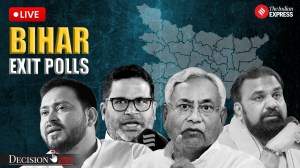Why President, Modi, Kejriwal, everyone is talking middle class in Delhi
There is no uniform definition of middle class and estimates vary depending on different studies. However, that the Capital has among the highest proportion of middle class is one constant.
 The Aam Aadmi Party (AAP) issued a “middle-class manifesto” this week, with a series of demands from the Centre. (Express photo)
The Aam Aadmi Party (AAP) issued a “middle-class manifesto” this week, with a series of demands from the Centre. (Express photo)Ahead of the Budget Session in Parliament, beginning just says ahead of voting in the Delhi Assembly elections, the middle class is on everyone’s lips.
While addressing the Parliament on Friday, President Droupadi Murmu linked the economic progress of India with the “aspirations of the middle class and the fulfilment of those aspirations”. After skipping any mention of the middle class in her June 2024 address, Murmu referred to the group eight times in her latest speech.
Earlier in the day, Prime Minister Narendra Modi, too, spoke of the middle class, saying: “I pray that Maa Lakshmi continues to bless the poor and middle class of our country and continues to shower her blessings.”
On January 23, Delhi’s ruling Aam Aadmi Party (AAP) issued a “middle-class manifesto” this week, with a series of demands from the Centre, including increasing the education and health allocations and raising the tax exemption limit.
Delhi is scheduled to vote on February 5, just days after the Budget is tabled in Parliament on February 1. With the release of a manifesto for the middle class, the ruling AAP is targeting a demographic group that had helped vault the party into prominence following the India Against Corruption movement but is broadly seen as identifying most with the Opposition BJP.
Post-poll survey data published by the Lokniti-CSDS, an independent research institute, showed that the BJP narrowed the sizeable gaps between it and the AAP among the poor, lower-income and middle-income voters between the 2015 and 2020 polls. Though the AAP maintained its lead in 2020 among middle-class voters, en route to a repeat near sweep of Delhi’s 70 Assembly seats, party leaders admit it is viewed as a party solely “for the poor”.
In a video address while announcing the middle-class manifesto, AAP national convener Arvind Kerjiwal acknowledged his party’s focus on “underprivileged” groups, but linked the same to the middle class. “You might wonder why your money is being used to support the poor… Today, many middle-class people living in small towns and cities have parents who were once poor. They worked hard to transition out of poverty, become the middle class and provide a better life for their children. If they had received even a little support from the government back then – like we are providing today – they would have saved more and done even better for you,” he said.
Defining the middle class
But with this political emphasis on the middle class comes the difficult task of defining this group. There is no uniform definition of the middle class, particularly in the Indian context. Many Indian definitions of the middle class clash with global definitions, and the sparse availability of household consumption and expenditure data further complicates estimations of India’s middle class population. While some estimates are income-based, others are consumption-based; alternative measures include counting the number of taxpayers or on the basis of education and occupation.
For instance, a survey report published by the People Research on India’s Consumer Economy (PRICE) in 2022 defined a middle-class household as one that earns between Rs 5 lakh and Rs 30 lakh per year, and a middle-class individual as one who earns between Rs 1.09 lakh and Rs 6.46 lakh a year.
The National Council of Applied Economic Research (NCAER), a government-private partnership body, however, places a middle-class household’s income between Rs 2 lakh and Rs 10 lakh per year.
Nobel Prize-winning economists Abhijit Banerjee and Esther Duflo, in 2008, defined the Indian middle class as having a daily per capita expenditure between $2 (roughly Rs 160) and $10 (Rs 800), or between Rs 58,000 and Rs 2.9 lakh a year.
But as far as the government is concerned, households earning less than Rs 8 lakh a year are considered a part of the Economically Weaker Section (EWS), making them eligible for some forms of reservation.
Counting the middle class
In 2022, PRICE published among the few city- and state-level estimates of middle class populations. In 2020-21, while India’s middle class accounted for roughly 31% of the population – about 43.2 crore people or over 94,000 households – PRICE put Delhi’s figures at 67.16%, or 28.26 lakh households, making the middle class the largest income-based sub-group in the national capital.
In contrast, Maharashtra’s middle class, much larger in size, accounts for just 34.24% of all its households. In fact, among the 10 richest states, Delhi had the highest proportion of middle-class households.
![[CHART: Share of middle-class households in 10 richest states]](https://images.indianexpress.com/2025/01/delhi-chart.png?resize=600,425) [CHART: Share of middle-class households in 10 richest states]
[CHART: Share of middle-class households in 10 richest states]
A survey conducted by non-profit Lok Foundation and the Centre for Monitoring Indian Economy (CMIE) in 2014 found that 64% of Delhiites self-identified as belonging to the middle class. Nationally, though, this figure stood at 49%. Similarly, the Lokniti-CSDS post-poll survey for Delhi in 2015 found that 71.6% of respondents identified as middle class – 27.8% as upper- and 43.8% as lower-middle class.
While national-level data on the middle class is more readily available, the figures vary greatly across sources. For instance, an analysis by Oxford Economics, associated with Oxford University, showed that in 2022 there were 46 crore middle-class Indians. In 2021, an analysis by the Pew Research Center, a US-based think tank, found that India’s middle-income population (defined by it as households with a daily per capita consumption of $10 to $20), fell from 9.9 crore people before the Covid-19 pandemic to 6.6 crore after. Based on its latest estimate, the middle class accounts for just 4.78% of India’s population. According to Pew, a vast majority of Indians fall within the low-income category, comprising those with daily per capita consumption between $2 and $10.
Some older estimates, including those based on the India Human Development Survey (IHDS), designed by researchers at the University of Maryland in the US and the NCAER, found that in 2011-12 India’s middle class made up 28.05% of the population. However, another analysis of the IHDS data from 2014 put the proportion of middle class households (defined as those with annual incomes between Rs 55,000 and Rs 88,000) at 40%. One government estimate, calculated on the basis of taxpayers, put the middle class numbers at 2.87 crore in 2011-12 or roughly 2% of the pop



- 01
- 02
- 03
- 04
- 05




























